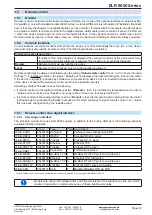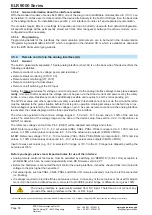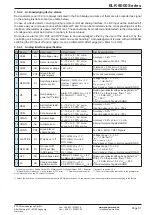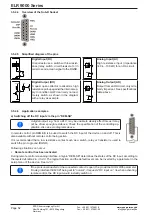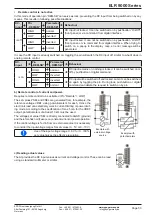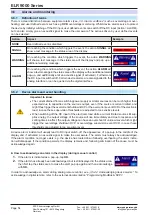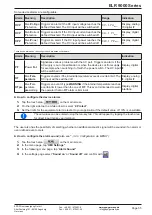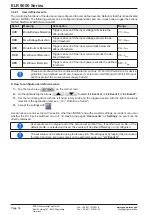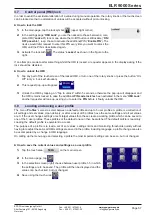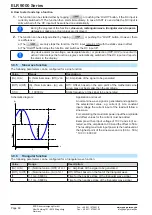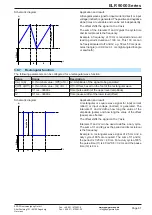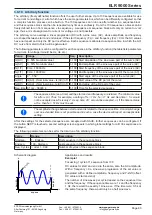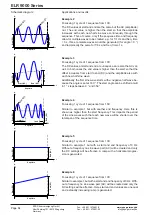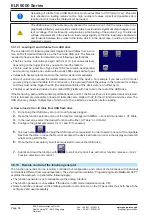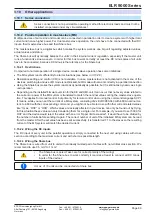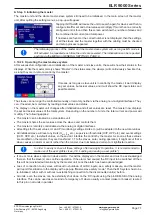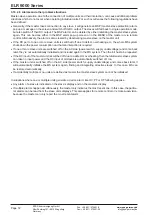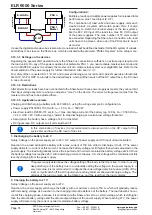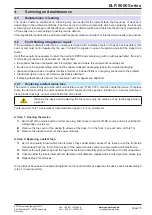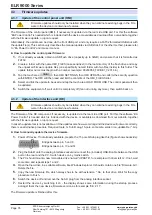
Page 62
EPS Stromversorgung GmbH
Alter Postweg 101 • 86159 Augsburg
Germany
ELR 9000 Series
Fon: +49 821 / 570451-0
Fax: +49 821 / 570451-25
3.9.8 Trapezoidal function
The following parameters can be configured for a trapezoidal curve function:
Value
Range
Description
I(A), U(A)
0...(Nominal value - (Off)) of U, I
A = Amplitude of the signal to be generated
I(Off), U(Off) 0...(Nominal value - (A)) of U, I
Off = Offset, based on the foot of the trapezium
t1
0.1 ms...36000 s
Time for the negative slope of the trapezoidal wave signal
t2
0.1 ms...36000 s
Time for the top value of the trapezoidal wave signal
t3
0.1 ms...36000 s
Time for the negative slope of the trapezoidal wave signal
t4
0.1 ms...36000 s
Time for the base value (offset) of the trapezoidal wave signal
Schematic diagram:
Application and result:
O
ffse
t
t
A
A
m
plit
ud
e
t1
t2
t3
t4
Here a trapezoidal signal can be applied to a set value
of U or I. The slopes of the trapezium can be different
by setting different times for gain and decay.
The periodic duration and repeat frequency are the
result of four time elements. With suitable settings the
trapezium can be deformed to a triangular or rectangular
wave. It has, therefore, universal use.
3.9.9 DIN 40839 function
This function is based on the curve defined in DIN 40839 / EN ISO 7637 (test impulse 4), and is only applicable
to voltage. It shall replicate the progress of automobile battery voltage during engine starting. The curve is divided
into 5 sequences (see diagram below) which each have the same parameters. The standard values from the DIN
are set already as default values for the five sequences.
The following parameters can be configured for the DIN40839 function:
Value
Range
Seq Description
Ustart
0...Nominal value of U 1-5
Start voltage of the ramp
Uend
0...Nominal value of U 1-5
End voltage of the ramp
Seq.time
0.1 ms...36000 s
1-5
Time of the ramp
Seq.cycles
∞ or 1...999
-
Number of repetitions of the entire curve
Time t1
0.1 ms...36000 s
-
Time after cycle before repetition (cycle <> 1)
Schematic diagram:
Application and result:
t
A
U s
ta
rt
1
2
3
4
5
t1
Sequences
The function’s primary use is to load a source, i. e. power
supply, which cannot generate the curve itself and would
supply a static DC voltage. The load acts as a sink for
the rapid fall of the output voltage of the power supply
enabling the voltage progress to follow the DIN curve.
The only requirement for the source is that it features
(an adjustable) current limitation.
The curve conforms to test impulse 4 of the DIN. With
suitable settings, other test impulses can be simulated.
If the curve in sequence 4 should be a sine wave, then
these 5 sequences would have to be reconstructed using
the arbitrary generator.


